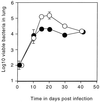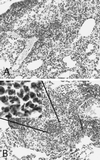Transient loss of resistance to pulmonary tuberculosis in p47(phox-/-) mice
- PMID: 10678931
- PMCID: PMC97272
- DOI: 10.1128/IAI.68.3.1231-1234.2000
Transient loss of resistance to pulmonary tuberculosis in p47(phox-/-) mice
Abstract
Mycobacterium tuberculosis is an important respiratory pathogen the growth of which is controlled primarily by cytokine-activated macrophages. One of the principal mediators of this control is nitric oxide; however, superoxide has recently been shown to be protective in systemic mycobacterial infections. To determine whether superoxide is important in controlling M. tuberculosis during primary pulmonary infection, mice lacking the cytosolic p47(phox) gene (which is essential for effective superoxide production by the NADPH oxidase) were infected aerogenically. The lack of superoxide during an aerosol infection with M. tuberculosis resulted in a significant increase in bacterial growth over the early period of infection. Once antigen-specific gamma interferon-producing lymphocytes were detected in the draining lymph nodes, however, bacterial growth in the lung stopped. One interesting consequence of the lack of superoxide was an increase in neutrophilic infiltrates within the granuloma. This may be a consequence of increased tissue damage due to more rapid bacterial growth or may reflect a role for superoxide in controlling inflammation.
Figures



References
-
- Adams L B, Dinauer M C, Morgenstern D E, Krahenbuhl J L. Comparison of the roles of reactive oxygen and nitrogen intermediates in the host response to Mycobacterium tuberculosis using transgenic mice. Tuberc Lung Dis. 1997;78:237–246. - PubMed
-
- Allen D M, Chng H H. Disseminated Mycobacterium flavescens in a probable case of chronic granulomatous disease. J Infect. 1993;26:83–86. - PubMed
Publication types
MeSH terms
Substances
Grants and funding
LinkOut - more resources
Full Text Sources
Other Literature Sources
Molecular Biology Databases

